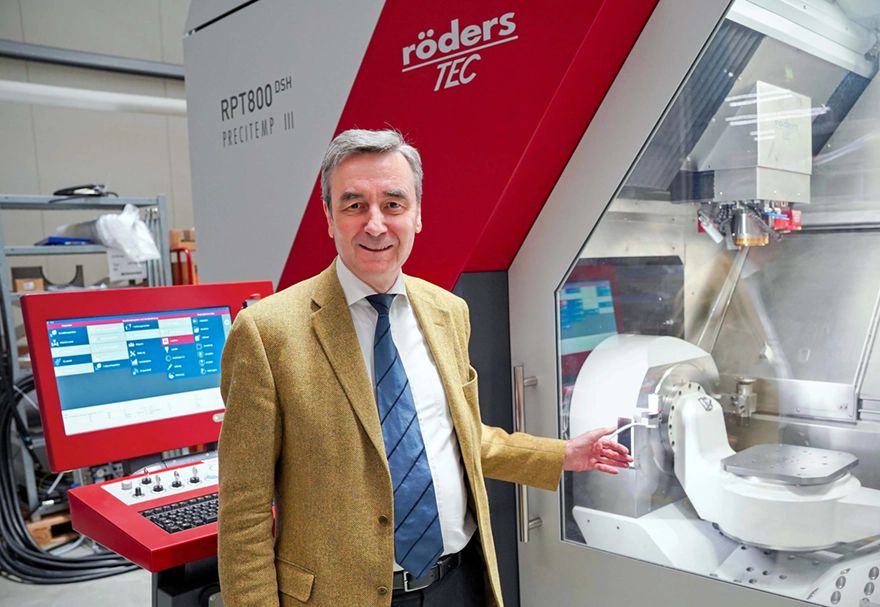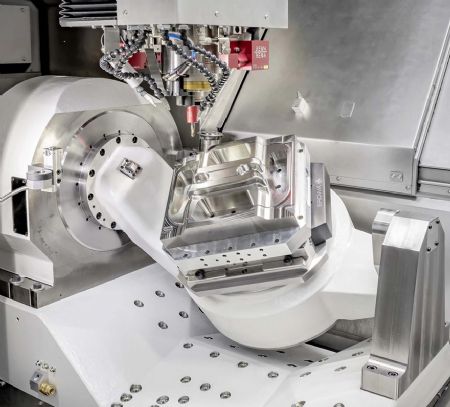 Sixth-generation managing director Juergen Roeders in front of an RPT800DSH five-axis VMC in the assembly hall at Roeders’ factory in Soltau, Germany
Sixth-generation managing director Juergen Roeders in front of an RPT800DSH five-axis VMC in the assembly hall at Roeders’ factory in Soltau, GermanyGermany-based
Roeders, a vertical machining centre (VMC) manufacturer which sells machines into the UK and Irish markets via sole agent
Hurco Europe, High Wycombe, is in the process of rolling out a new range of milling machines, with optional integral grinding capability, that can achieve extraordinarily tight tolerances on workpieces.
The RPT series of three- and five-axis VMCs are said to be able to achieve tolerances half those obtainable using Roeders’ established RXP machines, which already achieve world-class accuracy and surface finish. Furthermore, the latest VMCs can be kept geometrically stable to within ±1µm, even if the ambient temperature fluctuates as much as 3°C.
Achieving this level of precision would normally require the machine tool to be housed in an air conditioned environment, but this would entail considerable expense both to install and to power. Roeders has concentrated instead on holistic temperature management within the machine and has transcended conventional methods with the integration of PRECITEMP technology to achieve a high level of consistency and repeatability. Three increasingly sophisticated levels of temperature compensation and sensor feedback to the CNC system may be specified by a customer, according to their requirements.
A combination of some or all of the following cooling measures can be involved: temperature control of, for the first time, the machine table and rotary axis bearings in addition to the torque motors in the trunnion-type five-axis machines, and of the air in the working area, surrounding the axis drives and in upper part of the machine guarding.
Thermal stability of the portal structure and machine bed is maintained by embedded pipework carrying chilled water. There is similar circuitry for the spindle and its surrounding sleeve to prevent growth in the Z axis, which is monitored to sub-micron accuracy by an external, non-contact sensor. Any remaining minimal residual errors are compensated for by software algorithms derived in the course of the development process of the machines.
 Pictured right: machining area of the RPT800DSH in which, for the first time, the machine table and rotary axis bearings, in addition to the torque motors, are thermally controlled. Spindle zero point in the Z-axis is measured to sub-micron accuracy using an external, non-contact sensor to enable growth compensation
Pictured right: machining area of the RPT800DSH in which, for the first time, the machine table and rotary axis bearings, in addition to the torque motors, are thermally controlled. Spindle zero point in the Z-axis is measured to sub-micron accuracy using an external, non-contact sensor to enable growth compensationDuring milling, displacements occur orthogonally to the direction of axis travel. Although these lie in the sub-micron range, they can negatively impact surface quality when machining a workpiece using a ball nose milling cutter, for example. So to minimise even these tiny movements, Roeders has adopted NANOTOL technology, whereby the carriages housing the roller bearings along the linear axes have been optimised to reduce transverse movement, significantly improving precision.
The structural integrity of the RPT series has been meticulously engineered to minimise vibration. The robust machine frame, coupled with advanced damping technology, creates a stable platform on which the most intricate machining operations can be performed reliably. This foundation underpins an ability to deliver exceptional surface finish and dimensional accuracy, even at high machining speeds.
A big market for Roeders machines worldwide is the mould and die-making sector, where the high surface finish obtainable minimises and sometimes eliminates the need for hand finishing. However, there is a tendency for ever higher precision to be specified on drawings in other industries as well, notably aerospace and medical, which RPT machines are well suited to achieve.
Roeders understands that precision is not just about static accuracy, but about maintaining that accuracy throughout the entire machining process, under dynamic loads and varying cutting conditions. Driving the RPT series is the manufacturer’s intuitive, powerful CNC system, designed with the operator in mind. The control simplifies programming and optimises machining processes, allowing complex toolpaths and advanced machining strategies to be generated, and its user-friendly interface reduces set-up times and increases overall productivity.
In the world of high-precision manufacturing, rapid set-up and vigilant monitoring of the machining process are important, so improvements have been made to the operator's visibility, and access from two sides, into the working area. The doors now open at the touch of a button for added convenience, while automation is also facilitated by the new design.
Futhermore, machine uptime is a critical factor, so ease of servicing has been prioritised. The modular construction and ready accessibility to interior components simplify maintenance procedures, minimising downtime and maximising availability.